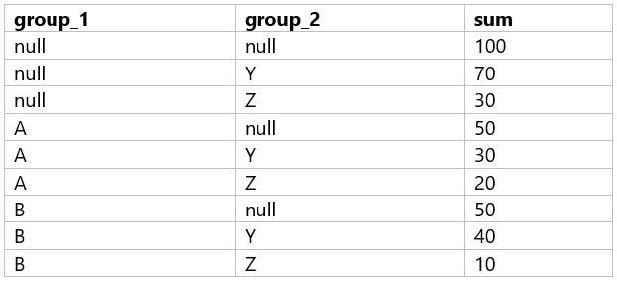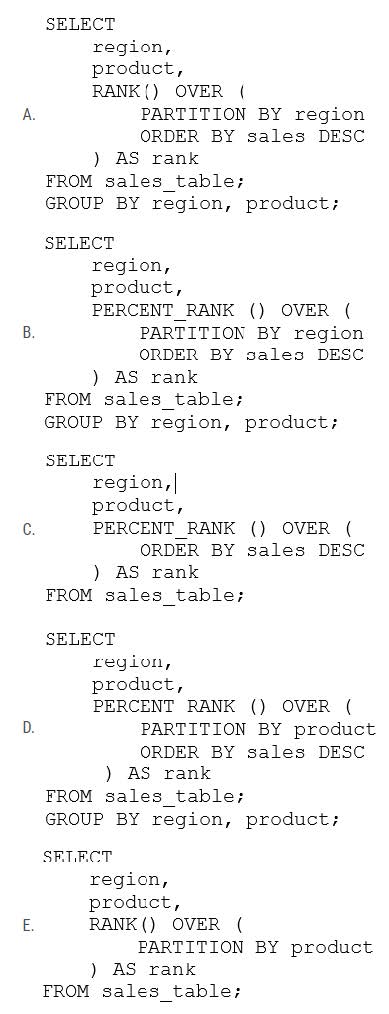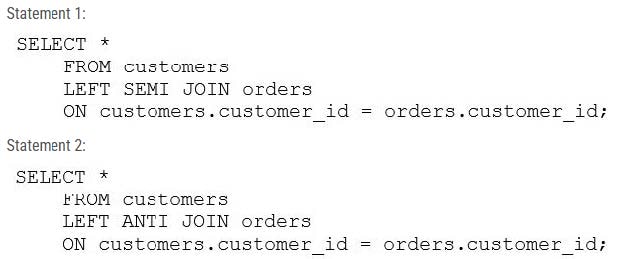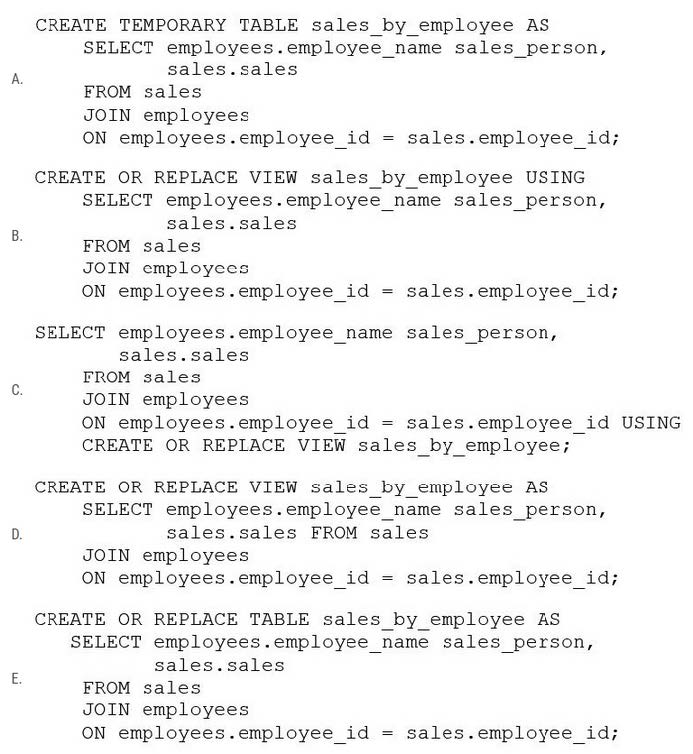Exam Details
Exam Code
:DATABRICKS-CERTIFIED-DATA-ANALYST-ASSOCIATEExam Name
:Databricks Certified Data Analyst AssociateCertification
:Databricks CertificationsVendor
:DatabricksTotal Questions
:45 Q&AsLast Updated
:Jul 01, 2025
Databricks Databricks Certifications DATABRICKS-CERTIFIED-DATA-ANALYST-ASSOCIATE Questions & Answers
-
Question 11:
Which of the following statements about a refresh schedule is incorrect?
A. A query can be refreshed anywhere from 1 minute to 2 weeks.
B. Refresh schedules can be configured in the Query Editor.
C. A query being refreshed on a schedule does not use a SQL Warehouse (formerly known as SQL Endpoint).
D. A refresh schedule is not the same as an alert.
E. You must have workspace administrator privileges to configure a refresh schedule.
-
Question 12:
How can a data analyst determine if query results were pulled from the cache?
A. Go to the Query History tab and click on the text of the query. The slideout shows if the results came from the cache.
B. Go to the Alerts tab and check the Cache Status alert.
C. Go to the Queries tab and click on Cache Status. The status will be green if the results from the last run came from the cache.
D. Go to the SQL Warehouse (formerly SQL Endpoints) tab and click on Cache. The Cache file will show the contents of the cache.
E. Go to the Data tab and click Last Query. The details of the query will show if the results came from the cache.
-
Question 13:
Which of the following is a benefit of Databricks SQL using ANSI SQL as its standard SQL dialect?
A. It has increased customization capabilities
B. It is easy to migrate existing SQL queries to Databricks SQL
C. It allows for the use of Photon's computation optimizations
D. It is more performant than other SQL dialects
E. It is more compatible with Spark's interpreters
-
Question 14:
A data analyst is processing a complex aggregation on a table with zero null values and their query returns the following result:

Which of the following queries did the analyst run to obtain the above result?

A. Option A
B. Option B
C. Option C
D. Option D
E. Option E
-
Question 15:
A data analyst has been asked to use the below table sales_table to get the percentage rank of products within region by the sales:

The result of the query should look like this:

Which of the following queries will accomplish this task?

A. Option A
B. Option B
C. Option C
D. Option D
E. Option E
-
Question 16:
In which of the following situations should a data analyst use higher-order functions?
A. When custom logic needs to be applied to simple, unnested data
B. When custom logic needs to be converted to Python-native code
C. When custom logic needs to be applied at scale to array data objects
D. When built-in functions are taking too long to perform tasks
E. When built-in functions need to run through the Catalyst Optimizer
-
Question 17:
Consider the following two statements:

Which of the following describes how the result sets will differ for each statement when they are run in Databricks SQL?
A. The first statement will return all data from the customers table and matching data from the orders table. The second statement will return all data from the orders table and matching data from the customers table. Any missing data will be filled in with NULL.
B. When the first statement is run, only rows from the customers table that have at least one match with the orders table on customer_id will be returned. When the second statement is run, only those rows in the customers table that do not have at least one match with the orders table on customer_id will be returned.
C. There is no difference between the result sets for both statements.
D. Both statements will fail because Databricks SQL does not support those join types.
E. When the first statement is run, all rows from the customers table will be returned and only the customer_id from the orders table will be returned. When the second statement is run, only those rows in the customers table that do not have at least one match with the orders table on customer_id will be returned.
-
Question 18:
A data analyst has created a user-defined function using the following line of code:
CREATE FUNCTION price(spend DOUBLE, units DOUBLE)
RETURNS DOUBLE
RETURN spend / units;
Which of the following code blocks can be used to apply this function to the customer_spend and customer_units columns of the table customer_summary to create column customer_price?
A. SELECT PRICE customer_spend, customer_units AS customer_priceFROM customer_summary
B. SELECT priceFROM customer_summary
C. SELECT function(price(customer_spend, customer_units)) AS customer_priceFROM customer_summary
D. SELECT double(price(customer_spend, customer_units)) AS customer_priceFROM customer_summary
E. SELECT price(customer_spend, customer_units) AS customer_priceFROM customer_summary
-
Question 19:
A data analyst has been asked to count the number of customers in each region and has written the following query:

If there is a mistake in the query, which of the following describes the mistake?
A. The query is using count(*), which will count all the customers in the customers table, no matter the region.
B. The query is missing a GROUP BY region clause.
C. The query is using ORDER BY, which is not allowed in an aggregation.
D. There are no mistakes in the query.
E. The query is selecting region, but region should only occur in the ORDER BY clause.
-
Question 20:
A business analyst has been asked to create a data entity/object called sales_by_employee. It should always stay up-to-date when new data are added to the sales table. The new entity should have the columns sales_person, which will be the name of the employee from the employees table, and sales, which will be all sales for that particular sales person. Both the sales table and the employees table have an employee_id column that is used to identify the sales person.
Which of the following code blocks will accomplish this task?

A. Option A
B. Option B
C. Option C
D. Option D
E. Option E
Related Exams:
DATABRICKS-CERTIFIED-ASSOCIATE-DEVELOPER-FOR-APACHE-SPARK
Databricks Certified Associate Developer for Apache Spark 3.0DATABRICKS-CERTIFIED-DATA-ANALYST-ASSOCIATE
Databricks Certified Data Analyst AssociateDATABRICKS-CERTIFIED-DATA-ENGINEER-ASSOCIATE
Databricks Certified Data Engineer AssociateDATABRICKS-CERTIFIED-GENERATIVE-AI-ENGINEER-ASSOCIATE
Databricks Certified Generative AI Engineer AssociateDATABRICKS-CERTIFIED-PROFESSIONAL-DATA-ENGINEER
Databricks Certified Data Engineer ProfessionalDATABRICKS-CERTIFIED-PROFESSIONAL-DATA-SCIENTIST
Databricks Certified Professional Data ScientistDATABRICKS-MACHINE-LEARNING-ASSOCIATE
Databricks Certified Machine Learning AssociateDATABRICKS-MACHINE-LEARNING-PROFESSIONAL
Databricks Certified Machine Learning Professional
Tips on How to Prepare for the Exams
Nowadays, the certification exams become more and more important and required by more and more enterprises when applying for a job. But how to prepare for the exam effectively? How to prepare for the exam in a short time with less efforts? How to get a ideal result and how to find the most reliable resources? Here on Vcedump.com, you will find all the answers. Vcedump.com provide not only Databricks exam questions, answers and explanations but also complete assistance on your exam preparation and certification application. If you are confused on your DATABRICKS-CERTIFIED-DATA-ANALYST-ASSOCIATE exam preparations and Databricks certification application, do not hesitate to visit our Vcedump.com to find your solutions here.